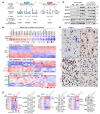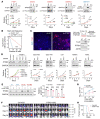RNA splicing analysis deciphers developmental hierarchies and reveals therapeutic targets in adult glioma
- PMID: 38662454
- PMCID: PMC11142752
- DOI: 10.1172/JCI173789
RNA splicing analysis deciphers developmental hierarchies and reveals therapeutic targets in adult glioma
Abstract
Widespread alterations in RNA alternative splicing (AS) have been identified in adult gliomas. However, their regulatory mechanism, biological significance, and therapeutic potential remain largely elusive. Here, using a computational approach with both bulk and single-cell RNA-Seq, we uncover a prognostic AS signature linked with neural developmental hierarchies. Using advanced iPSC glioma models driven by glioma driver mutations, we show that this AS signature could be enhanced by EGFRvIII and inhibited by in situ IDH1 mutation. Functional validations of 2 isoform switching events in CERS5 and MPZL1 show regulations of sphingolipid metabolism and SHP2 signaling, respectively. Analysis of upstream RNA binding proteins reveals PTBP1 as a key regulator of the AS signature where targeting of PTBP1 suppresses tumor growth and promotes the expression of a neuron marker TUJ1 in glioma stem-like cells. Overall, our data highlights the role of AS in affecting glioma malignancy and heterogeneity and its potential as a therapeutic vulnerability for treating adult gliomas.
Keywords: Brain cancer; Cell biology; Molecular biology; Oncology; RNA processing.
Conflict of interest statement
Figures









References
-
- Nicholson JG, Fine HA. Diffuse glioma heterogeneity and its therapeutic implications. Cancer Discov. 2021;11(3):575–590. doi: 10.1158/2159-8290.CD-20-1474. - DOI - PubMed
MeSH terms
Substances
Grants and funding
- R01 NS117104/NS/NINDS NIH HHS/United States
- R01 NS116802/NS/NINDS NIH HHS/United States
- R21 CA209345/CA/NCI NIH HHS/United States
- F99 CA234799/CA/NCI NIH HHS/United States
- P30 CA060553/CA/NCI NIH HHS/United States
- K00 CA234799/CA/NCI NIH HHS/United States
- P50 CA221747/CA/NCI NIH HHS/United States
- R21 NS126810/NS/NINDS NIH HHS/United States
- R56 NS080939/NS/NINDS NIH HHS/United States
- R21 NS122375/NS/NINDS NIH HHS/United States
- R01 CA258248/CA/NCI NIH HHS/United States
- K99 CA279896/CA/NCI NIH HHS/United States
- R01 NS115403/NS/NINDS NIH HHS/United States
- R01 NS133160/NS/NINDS NIH HHS/United States
- R01 NS125318/NS/NINDS NIH HHS/United States
- R01 NS080939/NS/NINDS NIH HHS/United States
LinkOut - more resources
Full Text Sources
Research Materials
Miscellaneous

